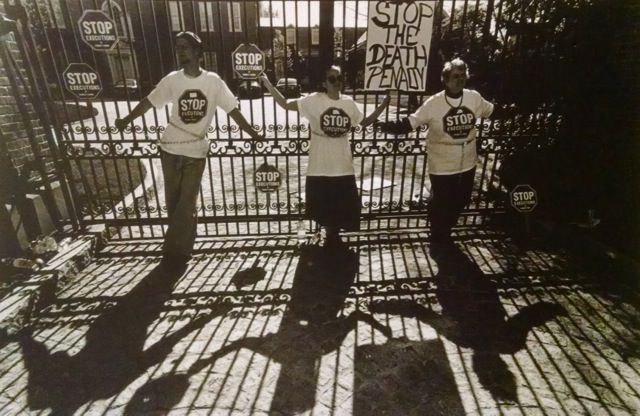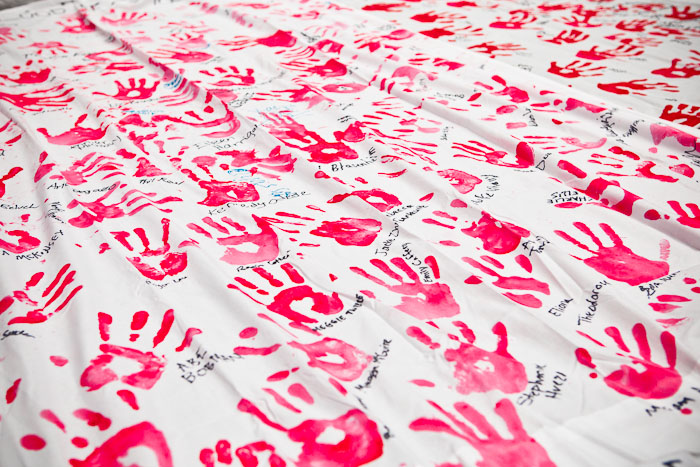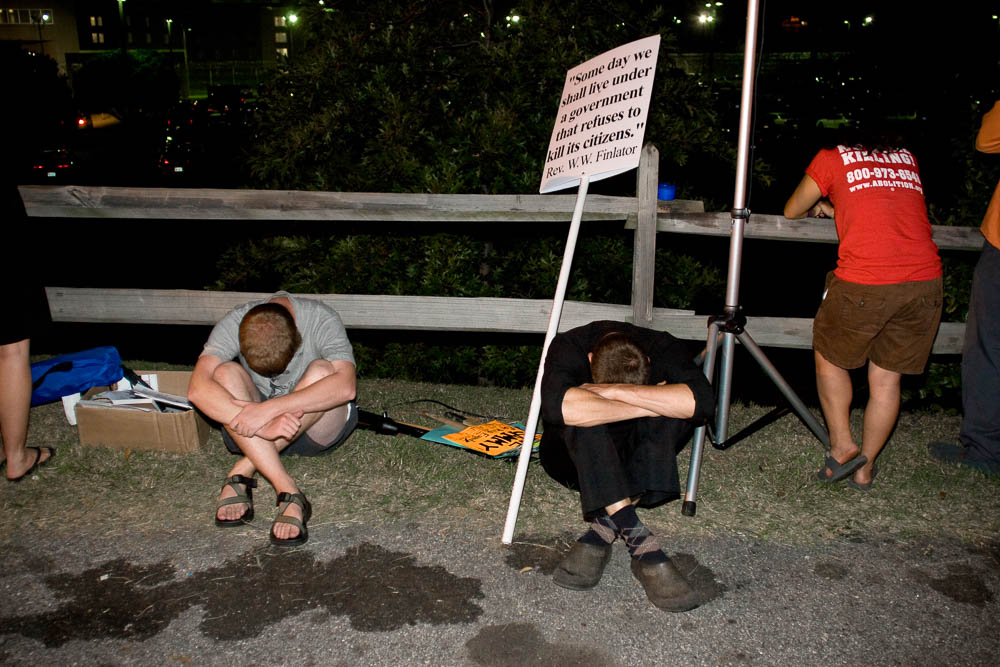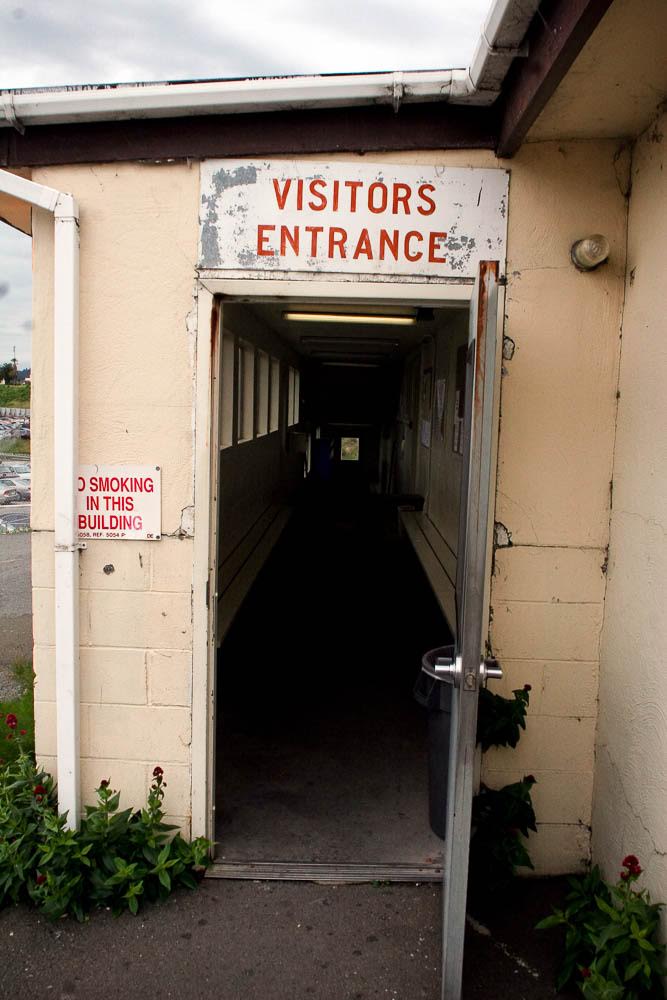The Faces and Stories Gallery
Executing Grace is not just about an "issue". It is about the human lives affected by violent crime and the state-sanctioned violence of execution. In writing the book, Shane interviewed family members of murder victims and family members of the executed. He interviewed survivors of death row who spent decades in prison for crimes they had nothing to do with. And he talked with prison wardens, lawyers, even folks responsible for overseeing executions. Here are some of the photos of the people who have inspired Executing Grace. Many of their stories are in the book. We are grateful to our epic photographer friend Scott Langley for offering his photos.
(unless noted otherwise, all photos are by Scott Langley: http://scottlangleyphoto.com)
PEOPLE
Bill Babbitt holding a photo of his brother Manny, who fought in the Marines in the siege of Khe Sanh. He came back very troubled from the war. After a violent crime, Bill turned his brother in after being assured that the authorities would help him get medical treatment, and would not seek the death penalty. Tragically, Manny was executed on his birthday. Shane interviewed Bill for the section entitled, "A Brother's Lament." There is an Oscar-nominated film about Bill and Manny entitled, "Last Day of Freedom."
Curtis McCarty spent his entire adult life in prison for a crime he had nothing to do with. He's story is in the chapter on innocence.
Vigil for Reggie Clemons who was weeks away from execution. His murder conviction was later thrown out.
SueZann Bossler, who is speaking here, was a victim of violent crime. She survived but her father did not. In court, when she voiced her opposition to the death penalty she was threatened with contempt of court, a $500 fine, and 6 months in jail. She reminds of us of how many murder victims' family members have been silenced if they are not in favor of execution. On her right is Art Laffin, whose brother was killed by a man with mental illness. They both work with Murder Victims' Families for Reconciliation and Murder Victims' Families for Human Rights. Shane tells both of their stories in the chapter "Let's Begin With the Victims."
Vigil for Reggie Clemons who was weeks away from execution. His murder conviction was later thrown out.
These are the survivors of death row. 156 people have been exonerated since 1973 -- and together they have spent 1779 years in prison after being wrongfully-convicted.
Witness to Innocence is led by these exonerees, and is one of the groups we are proud to support.
For every 9 people executed, 1 has been exonerated. Can you imagine if one in every 10 planes crashed?
We don't always think about what the death penalty does to those who are execute.
This is Ron McAndrew speaking. He is a former prison warden who oversaw executions in Florida. He is now a jail and prison consultant. Shane interviewed him in the chapter on "The Haunted Executioners".
SueZann Bossler, who is speaking here, was a victim of violent crime. She survived but her father did not. In court, when she voiced her opposition to the death penalty she was threatened with contempt of court, a $500 fine, and 6 months in jail. She reminds of us of how many murder victims' family members have been silenced if they are not in favor of execution. On her right is Art Laffin, whose brother was killed by a man with mental illness. They both work with Murder Victims' Families for Reconciliation and Murder Victims' Families for Human Rights. Shane tells both of their stories in the chapter "Let's Begin With the Victims."
This is Randy Steidl. He is the Chair of the Board for Witness to Innocence. He also spent 12 years on death row after being wrongfully-convicted and sentenced to die in a case riddled with corruption and incompetence. Shane and Randy did a death penalty forum together that you can find a link to under our "Resources."
Randy Steidl, Chair of the Board for Witness to Innocence, sharing his story. Randy spent 12 years on death row after being wrongfully-convicted and sentenced to die in a case riddled with corruption and incompetence. Shane and Randy did a death penalty forum together that you can find a link to under our "Resources.
Both of Nyasha's parents were killed when she was a child, in what she thought to be a car accident. Many years later she discovered they were assassinated, and the man who killed them came to confess this to her. After much soul-searching she forgave him. And on father's day, he became a Christian. She baptized him. She is a hero and a champion for restorative justice in Zimbabwe. She's featured as one of the "Faces of Grace" in the book.
Both of Nyasha's parents were killed when she was a child, in what she thought to be a car accident. Many years later she discovered they were assassinated, and the man who killed them came to confess this to her. After much soul-searching she forgave him. And on father's day, he became a Christian. She baptized him. She is a hero and a champion for restorative justice in Zimbabwe. She's featured as one of the "Faces of Grace" in the book.
Shane, Billy Moore, and Heather Beaudoin. Heather works with Equal Justice USA, one of the most powerful groups in the country working for alternatives to the death penalty and for prison reform. They are one of the groups with whom we are proud to share proceeds from the book.
This is Billy Neal Moore, one of Shane's favorite redemption stories. Billy was convicted of murder and faced execution. But the victim's family forgave him. They fought to stop his execution. Through it all, Billy dedicated his life to Jesus... and now he is a pastor.
On the wall, at the Equal Justice Initiative in Montgomery, Alabama. This is George Stinney. Shane tells his story in the first chapter of Executing Grace. He was 14yrs old when he was executed in South Carolina in 1944, for a crime many claimed he was innocent of. His trial lasted less than a day. He was too small for the electric chair, and witnesses say the authorities had him sit on the Bible. In 2014, a South Carolina judge vacated his sentence... 70 years too late.
Shane and friends down at Equal Justice Initiative. Pictured here are Bryan Stevenson (far left) and Anthony Ray Hinton (second from left) and Carlos Malave. Mr. Hinton was wrongfully convicted and spent 30 years in prison for a crime he didn't commit. And 16 of those years in prison were AFTER proving his innocence. Shane tells Mr. Hinton's story in the book.
A blurry picture of Shane and Bryan Stevenson embracing down in Montgomery, Alabama, at the Equal Justice Initiative Headquarters. Bryan was an incredible resource, and inspiration for Executing Grace. And Shane is donated some of the royalties to the wonderful, redemptive work of EJI. Oh, and if you haven't read Bryan's book Just Mercy -- it is a must read! And don't miss his TED Talk online. One of Bryan's many great lines, quoted in Executing Grace is this one: "We have a system that treats you better if you are rich and guilty in America than if you are poor and innocent."
A North Carolina judge suspending the death penalty in 2006. Executions in North Carolina continue to be halted, in part because the medical professionals refuse to comply. Doctors have said that it is a violation of their oath "to do no harm" and the medical association has backed them up.
Going to jail has played a major role in social change. Shane has a section on the book about the holy act of civil disobedience when it comes to the death penalty. All over the country folks have gone to jail protesting our government's practice of capital punishment. As Gandhi said, "Noncooperation with evil is as much a duty as cooperation with good."
photo by Harvey Finkle
Blast to the past. This pic is from the late 1990s. Shane and friends blocking the Governor's mansion in Pennsylvania to stop executions. And, yes, they are chained to the gate. They were eventually arrested... and sentenced to go to Citizenship Classes to train them on how to be better law-abiding citizens. One of them is a nun. What this also did was put the death penalty on trial. Can you imagine if people of faith put their bodies on the line to try and stop executions? Hmmm.
photo by Harvey Finkle
Shane with Mary Johnson-Roy. Her son was murdered, and Mary started an organization called From Death to Life. It is a support group for mothers whose kids have been killed, and for mothers whose kids have taken life. Shane met Mary after the book was almost done, and moved a few things around to include Mary's story in the book. It is a stunning story of forgiveness and grace. Mary ended up being next door neighbors with Oshea, the young man who killed her son many years earlier.
Other Images
This is the death chamber in Texas, where executions are carried out. Sadly, and ironically, it has a cross on the top. It's a reminder of how the death penalty has succeeded in America, not despite Christians but because of us. The Bible belt has become the death belt -- with 85% of executions happening in the Bible belt states, and around half of all executions here in the state of Texas.
"Equal Justice Under the Law" is inscribed on the U.S. Supreme Court. It is also a reminder that this is something an aspiration but not yet a reality, especially in regards the the death penalty. Often, the biggest predictor of who gets executed is not the atrocity of the crime, but where the crime was committed, the race of the victim, and how much money the defendant has. It is also true that a majority of death sentences now come from only 2% of the counties in the US. And in 2015, only 3 states were responsible for 85% of the executions. "Equal Justice Under the Law" is still a worthy and noble ambition.
The "manner of death" for those who are executed by the state is "Homicide" (see bottom left corner).
It is a legal homicide. It is a reminder that the task before us is to stop all killing -- both legal and illegal. Violence is the problem, not the solution.
"We need justice not revenge" -- sign at a vigil before an execution. Martin Luther King, Jr. said that the death penalty is society's final assertion that it will not forgive.
This is the graveyard in Texas where prisoners are buried, and where people who are executed are buried if their body is not claimed by the family. The graves are marked with a stone cross that bears the prisoner's Department of Corrections number and date of death. An "X" indicates that they were executed by the state. It is one more reminder of how the death penalty dehumanizes people -- who no longer have names, only numbers.
Vigil outside of an execution.
"Someday we shall live under a government that refuses to kill its citizens"... hopefully some day soon.
Many of the photos above were captured by photographer and friend Scott Langley.
Scott Langley is a human rights activist, advocate and photojournalist who has been documenting the death penalty since 1999. His long term project on the death penalty seeks to tell the story of executions in the United States – focusing on those impacted by the system. His documentary project can be found at www.deathpenaltyphoto.org.

































